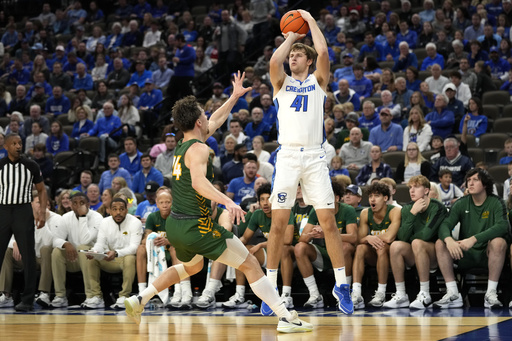OMAHA, Neb. (AP) — When Creighton basketball player Isaac Traudt’s teammates take a break at practice, they might grab a drink of water, chat it up or go over assignments.
Traudt does that, too, but not before he checks a device attached to his body that tells him his blood glucose level. Depending on what it says, he might need to grab some energy chews for a sugar bump. The routine is the same at halftime of games.
“I don’t think I’ve ever seen anybody put down a packet of chews faster than Isaac,” athletic trainer Ben McNair said. “He can probably put a pack of those down in 10 to 15 seconds.”
Traudt was diagnosed with Type 1 diabetes 16 years ago, at age 4, and he’s never let it stop him from pursuing the sport he loves. He will be with the Bluejays on Thursday when they open the NCAA Tournament against Akron in Pittsburgh.
The 6-foot-10, 235-pound forward grew up in Grand Island, 130 miles west of Omaha, and was a two-time all-state player and Nebraska high school player of the year in 2022. He spent his first college season at Virginia, sitting out as a redshirt, and announced his transfer to Creighton last March.
Traudt has appeared in 28 of the Bluejays’ 32 games, averaging just under 10 minutes per game and shooting 43.6% on 3-pointers. He started two games early in the season, and made five 3s and scored a season-high 18 points off the bench against Central Michigan.
Former NBA players Chris Dudley, Adam Morrison and Gary Forbes and former WNBA player Lauren Cox are among the high-level basketball players who have had to manage diabetes.
Traudt said he has had a number of parents of recently diagnosed children ask him to give their kids encouragement.
“It’s just important for them to know their dreams can still be accomplished,” Traudt said. “They can still compete in their sports. I think that’s what a lot of them worry about. I just want to inspire them and show you can play at the highest level.
“It doesn’t really matter if you have diabetes or not. It just takes more responsibility. It’s more demanding, but at the end of the day it’s possible.”
Dr. Lori Laffel, an endocrinologist and clinical investigator who works with children and young adults at the Harvard Medical School’s Joslin Diabetes Center, said technological advances have made it easier for athletes to manage their diabetes.
In the 1950s, she said, people diagnosed with Type 1 diabetes were discouraged from engaging in strenuous physical activity because of the dangers of low blood glucose. Later research showed positive effects from exercise, but athletes had to go through the inconvenience of pricking their fingers in practices and games to check their glucose.
In recent years, athletes have used continuous glucose monitors that communicate with insulin pumps to maintain glucose levels in their target ranges. The CGM sends readings to an app on the athlete’s phone showing glucose levels at five-minute intervals and also whether it is trending higher or lower.
Traudt said he had daily insulin injections until he switched at age 7 to an insulin pump. The modern insulin pump that he now uses can automatically adjust insulin, for example, delivering more insulin if his glucose goes too high and reducing insulin delivery when it goes too low. The pump and Dexcom CGM, which he has used since he was 13, are attached to his body under his uniform.
“Obviously, in my short lifetime it’s come a really long way,” he said. “Compared to 40 years ago, I couldn’t even imagine going through this without the technology. It would be really difficult.”
He doesn’t really need the CGM to know when his body is out of whack. When his blood sugar is low, he gets dizzy and fatigued. When it’s high, he gets thirsty and has body aches.
McNair said Traudt does a good job anticipating when he needs to up his blood glucose during practices and games.
“As soon as he feels like he’s going downhill a little bit, we do the chews for the most part and not too long after that he’s pretty much back on the floor,” McNair said.
Laffel, who has not treated Traudt and does not know him, said she can tell from hearing his story he has had strong support from his family and the medical and coaching staffs at Creighton.
“It’s always a thrill,” Laffel said, “when I know people are playing to their potential, working to their potential and thriving while living with Type 1 diabetes.”
___
AP March Madness bracket: https://apnews.com/hub/ncaa-mens-bracket and coverage: https://apnews.com/hub/march-madness
This website uses cookies so that we can provide you with the best user experience possible. Cookie information is stored in your browser and performs functions such as recognising you when you return to our website and helping our team to understand which sections of the website you find most interesting and useful.
